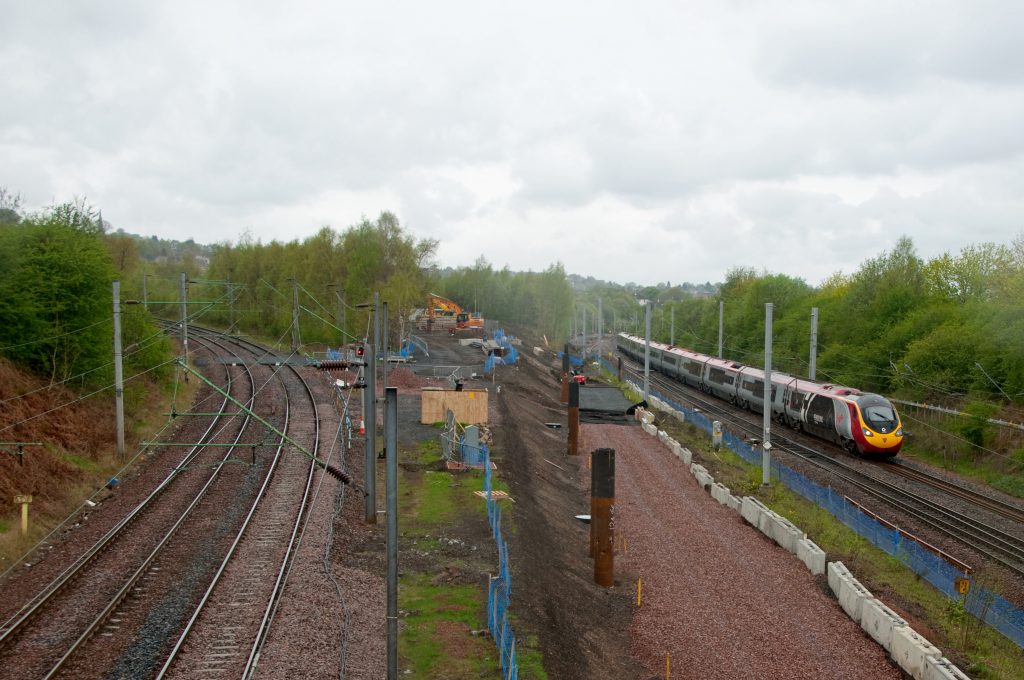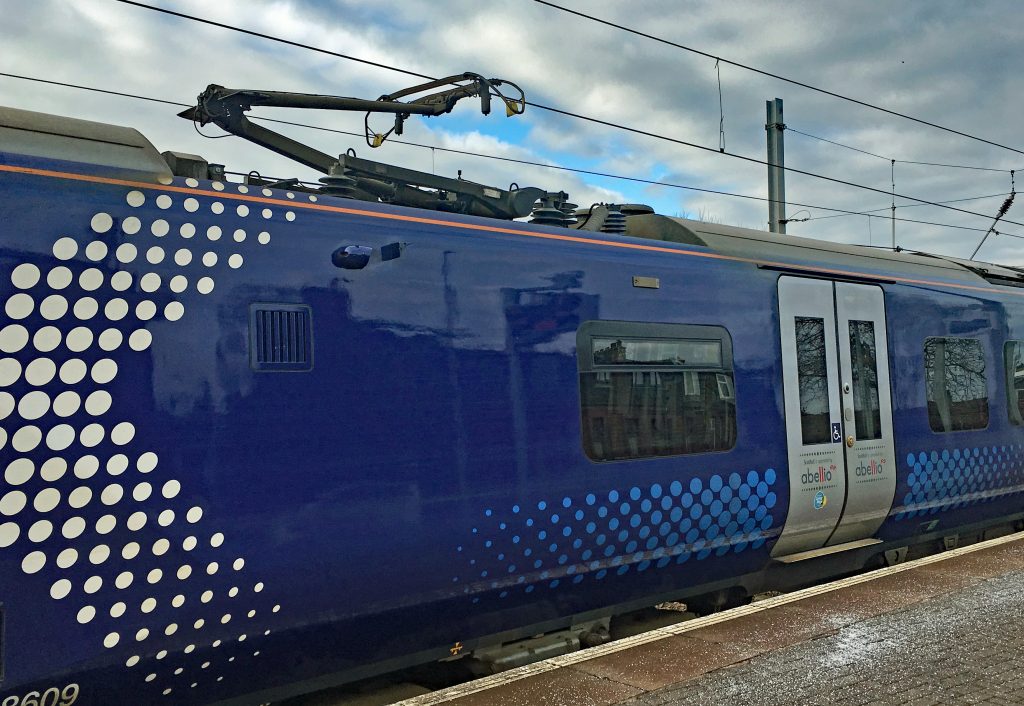On 25 August, Network Rail announced that, for six months on Mondays to Thursdays, there would be no service after 20:30 on the main Edinburgh to Glasgow line due to ‘intensification of delivery’ of the Edinburgh to Glasgow Improvement Programme (EGIP).
Rail Engineer was interested to find out why. Having done so, it is only fair to warn readers that the result is a standards-heavy article.
The Scottish press responded with headlines such as “Blunder sees cables installed too low on Glasgow to Edinburgh rail line”, which led to livid and ill-informed on- line comments blaming Network Rail for this shambles. Some observations, however, were intended to be helpful, such as the suggestion that this problem could be solved if trains had smaller wheels.
August also saw publication by the Office of Rail and Road (ORR) of its “Annual efficiency and finance assessment of Network Rail”. This showed the cost of EGIP has risen by £32 million and is running six months late, with completion now scheduled for July 2017.
Understandably, the Scottish Parliament was not impressed and asked ScotRail Alliance chief executive Phil Verster to explain the EGIP cost and time overruns. He explained that Network Rail attempted to keep costs down by asking if it could risk assess things to get a derogation to avoid having to comply with a new stricter standard and stated: “Last year, when all the shenanigans started and the cost issues became really clear, it became obvious to the ScotRail Alliance that, if we had continued to debate the matter, we would have got late into the programme and built the railway only for the ORR to say that we could not run anything on it.”
Development of new standards
Six years ago, there were no such problems for the Airdrie to Bathgate project electrification, which included the first part of the Edinburgh to Glasgow main line electrification from Haymarket to Newbridge Junction.
Since then, an amended European Technical Standard for Interoperability (ENE TSI) for rail energy systems has been issued. European Standard BS EN 50122-1 “Railway applications. Fixed installations. Protective provisions relating to electrical safety and earthing” was updated and the Common Safety Method for risk evaluation and assessment (CSM RA) was introduced in support of the Railways and other Guided Systems (Safety) Regulations (ROGS) for placing subsystems into service.
The new ENE TSI concerns traction power supply infrastructure and came into force on 1 January 2015. Prior to then, much work was done to align previous standards to this TSI, including the production of Railway Group Standard GL/RT1210 “AC Energy Subsystem and Interfaces to Rolling Stock Subsystem” which contains the UK national technical rules mandated by ENE TSI.
This work was coordinated by RSSB and included the production of a strategy for the implementation of ENE TSI in 2011 which “notes that GB railway is constrained by its small loading gauge which is difficult and expensive to alter” and that “there should be a working presumption that current GB practice should be preserved unless a conscious decision to adopt standard European practice is made by industry through its stakeholder groups, having understood the economic consequences of such a decision”.
Annex G
GL/RT1210 came into force in 2015 and superseded GE/RT8025 “Electrical provisions for Electrified Lines”. In respect of the clearance between structures and overhead line equipment (OLE), GL/RT1210 specifies a minimum clearance of 270mm, although it permits smaller clearances where justified by a CSM RA compliant risk assessment.
Prior to 2015, GE/RT8025 allowed for “reduced” and “special reduced” clearances of 200mm and 150mm respectively. With the EGIP contract to rebuild 41 bridges to provide the required electrical clearance let in December 2011, the imposition of a revised clearance standard three years later was problematic.
Perhaps the most challenging requirement of GL/RT1210 is its mandate of Figure 4 of BS EN 50122-1:2011, which only allows live 25kV equipment within a 3.5 metre radius of the platform edge unless a CSMRA compliant risk assessment can justify reduced clearances. Prior to that, GE/RT8025 specified the minimum platform clearances to be those in Annex G, BS EN 50122. This is a UK special condition that takes account of the restricted British gauge by allowing a 2.75 metre radius of a platform edge.
However, in 2013, the relevant British Standards committee, which is not part of the railway standards process, expressed concerns about a minimum 2.75 metres clearance and, in 2013, updated BS EN 50122 with a national forward requiring that, until Annex G is revised, an appropriate risk assessment is essential if clearances less than specified in Figure 4 are used.
The clearance requirements of BS EN 50122 are, in effect, those that must be followed to comply with the Electricity at Work Regulations, which require potentially dangerous conductors to be suitably placed but do not define this requirement. In such cases, compliance with the relevant British Standard is generally the minimum deemed necessary to comply with the law.
RSSB advised Rail Engineer that, during the development of GL/RT1210, the energy standards committee, which includes representation from Network Rail, agreed that this standard should reflect the updated BS EN 50122 by specifying the European practice of a 3.5 metre minimum clearance unless an appropriate risk assessment was undertaken.
RSSB also mentioned the extensive consultation exercise for the standard that had attracted over 400 comments and that they understood there to be an industry consensus for this proposal. A senior source in Network Rail, however, commented that removing Annex G was a late change that they had not agreed to and that no one in the company had been consulted. Their view is consistent with the impact assessment for GL/RT1201 not mentioning standing surface clearance and stating that it will retain the use of Annex G.
Furthermore, there was also no assessment of the economic consequences of this decision as required by the TSI implementation strategy. In particular, there does not seem to have been any consideration of a minimum clearance of slightly less than 3.5 metres which, as will be seen, would have significantly reduced the impact of this standards change.
Projects and new standards
ENE TSI applies to “new, upgraded or renewed ‘energy’ subsystems”, so it is not concerned with the existing infrastructure. Its clearance requirements specify compliance with the notified national technical rules that are the relevant clauses of GL/RT1210.
For projects at an advanced stage, the 2008 Interoperability Directive allows EU member states to issue a derogation against a new TSI. Although the Department for Transport advised the EU that EGIP was such an advanced project, as it had “reached a significant degree of maturity when the TSI was published in terms of tenders, contracts and detailed design”, the project was not issued with a derogation so had to comply with GL/RT1210.
In the several years that it takes to deliver a major electrification project, there may be changes to standards which can only be retrospectively applied at significant cost. As an example, early decisions on bridge clearance work, for which the contract was let in 2011, would not have considered the need to modify low bridges at stations to meet the minimum clearance of 3.5 metres as this was not a requirement of the then-applicable standard GE/RT8025.
This illustrates the need to freeze standards at the project design phase, as acknowledged by the Interoperability Directive’s consideration of advanced projects. ORR has issued guidance on how this issue should be addressed for rolling stock projects, and similar advice is required for infrastructure projects.
Pantograph problem
As shown in the diagram, the minimum 3.5 metre clearance from the platform edge is only slightly encroached in the worst-case scenario of low wire height and a large platform-side stagger. Thus this clearance requirement should not be particularly problematic as far as overhead line equipment is concerned.
Train pantographs are another matter, as their arc horns are below contact wire height and protrude into the minimum 3.5 metre clearance area. BS EN 50122 does not consider how clearances should be measured when a train occupies the minimum clearance area as shown in the diagram. As this standard refers to “touching in a straight line”, it would be reasonable to measure the clearance distance in a straight line from pantograph to platform over the train body as shown in the diagram.
As indicated by the pantograph clearance diagram, measuring clearances in this way results in only a slight encroachment of the 3.5-metre clearance, with no encroachment at the platform edge.
In a letter dated 5 April 2016, ORR advised Network Rail of its doubts about this line of sight criteria as “other interpretations of BS EN 50122 are available that make it harder to meet the 3.5 metre benchmark” and that “it is foreseeable that people might make contact with a pantograph by reaching round the profile of a train”. The credibility of this response is considered below.
All trains have an orange warning band at cant rail level, typically 2.4 metres above the platform. On electric trains, this band must be at least 0.6 metres below roof-mounted exposed live conductors, so a total of three metres from the platform edge. To put this in context, only 1 in 50,000 of the UK population is over 2.06 metres tall. Should a much taller individual reach around the train’s cant rail, it is likely that he/she would anyway first contact the roof-mounted pantograph frame which is unaffected by wire height.
A good safety record
There are about four hundred stations on AC lines that were electrified, on average, around forty years ago. During this time, around fifteen billion passengers have used these stations with no known record of any passenger fatalities from 25kV electric shock. Version 8.1 of ‘Train and pantograph at station’ RSSB’s safety risk model (SRM) ranks estimates that a passenger fatality from 25kV electric shock at a station will occur once every 300 years. It shows that this represents 0.008 per cent of all risks to passengers.
No doubt for this reason, this risk is not mentioned in either the RSSB’s strategy “Leading Health and Safety on Britain’s Railway”, which promotes cross-industry action, or in its recent booklet on platform safety (which does mention the risk of third rail electric shock). Furthermore, a recent RSSB guide on station safety research included 24 topic areas, none of which was concerned with the risk from 25kV equipment.
This shows that 25kV electrification presents a very low risk to passengers, yet the industry should not be complacent. With increasing numbers of passengers having selfie-sticks, longer umbrellas and helium balloons, this is perhaps a risk that could be usefully considered by a cross- industry working group as it concerns both infrastructure and passenger behaviour.
Suitable and sufficient?
Whatever the standards, employers have a duty to make a suitable and sufficient assessment of the risks to those affected by their business. Furthermore, the Construction, Design and Management Regulations require project designers to eliminate, so far as is reasonably practicable, foreseeable risks to the health and safety of any person.
New standards requiring risk assessments for 25kV clearances under 3.5 metres are only reinforcing the need to comply with legislation, so why should this be a problem? The answer is the interpretation of what constitutes “a suitable and sufficient assessment of risk”.
The Health and Safety Executive’s publication “How to control risks at work” notes that “risk assessment is about identifying and taking sensible and proportionate measures to control the risks in your workplace, not about creating huge amounts of paperwork.” The ORR’s guidance on the CSM RA advises that hazards that are considered to have a ‘broadly acceptable’ risk need not be analysed further.
With 25kV equipment at stations not resulting in any accidents for many years, it could be argued that encroaching on the 3.5 metre clearance requires a simple generic risk assessment that records that the high cost of infrastructure alterations is grossly disproportionate. The CSM RA could similarly consider that this is a ‘broadly acceptable’ risk.
A generic assessment could also record that the pantograph’s infringement of the 3.5 metre minimum clearance is generally by a small amount. Trains are only at platforms for a short time, during which passengers are focused on boarding the train at doors away from the pantograph position. In addition, part of this risk is from the pantograph frame fixed to the train roof.
In April, a letter from ORR advised Network Rail that such pantograph infringements require highly detailed site-specific risk assessments which, amongst many other things, must identify likely exposure in terms of station usage, points of congregation in relation to potential pantograph positions, dimensions from platforms to fixed equipment and pantographs, identification of control measures and how these will satisfy the legal duty. This was a particularly onerous requirement for EGIP and other electrification project teams.
This letter also notes that the risk from pantographs requires an industry programme to develop insulated arc horns for use under the new Great Western wires. It states that “we recognise that an insulated pantograph solution, if viable, might not be available until after the introduction of electric services (on Great Western) and, therefore, that Network Rail might incur significant infrastructure costs in controlling the risk by other means before then”.
In addition, in its policy on electrical clearances published in October 2016, the ORR notes that the “costs of redesigning features and retrospective modifications due to the lack of rigour in the duty-holder’s original design should not be used to inform any cost-benefit analysis”. This implies that, for ongoing projects, Network Rail cannot use excessive cost as a reason to avoid retrospectively modifying previous designs to comply with GL/RT1210 and that designs undertaken in accordance with the then approved Group Standard GE/ RT8025 were flawed.
Proportionate action
ENE TSI embodies a pragmatic European approach to standards. It allows for projects at an advanced stage and enables member states to specify their own rules, for example to take account of UK restricted infrastructure clearances. Yet, in Britain, the standards changes resulting from this TSI have resulted in a more demanding regime by specifying a minimum pantograph clearance that cannot be achieved at stations with low bridges and an onerous method of assessing the risk to passengers from 25kV equipment at such stations.
Until a few years ago, standards required OLE to be designed to minimize the risk of injury and that, if necessary, a minimum platform clearance of 2.75 metres could be used. This requirement was met by keeping the contact wire at its normal height, resulting in platform clearances of around four metres unless there was a low structure. In such cases, the reduced clearances were closer to 3.5 metres than the then-allowed 2.75 metres. Whilst this approach has proved to be safe, it may not have been adequately documented in a risk assessment.
In its publication “Reducing risks, protecting people,” HSE states that good regulation requires proportionate action commensurate to the risks. Although 25kV equipment at stations has a good safety record, there is the potential for a fatality. This would require a literally extraordinary action by someone acting differently from the millions of passengers who use such stations each day.
The hazard is therefore a generic one of abnormal behaviour at stations, for which a key risk control is passenger management by the station operator. A cross-industry study to evaluate the electrocution risk at stations on the 25kV network would be an appropriate response to this risk. In contrast, the action currently required of electrification project teams does not consider the overall network risk and has resulted in significant costs and delay to their projects.
Rail Engineer believes that there must be broad lessons to be learnt from this issue which concern proportionate risk assessment, pragmatic regulation and standards development, including impact assessment, long-duration infrastructure projects, and effective communication of pending requirements. In short, all concerned need to understand why there were no such problems with electrification schemes delivered just a few years ago.






